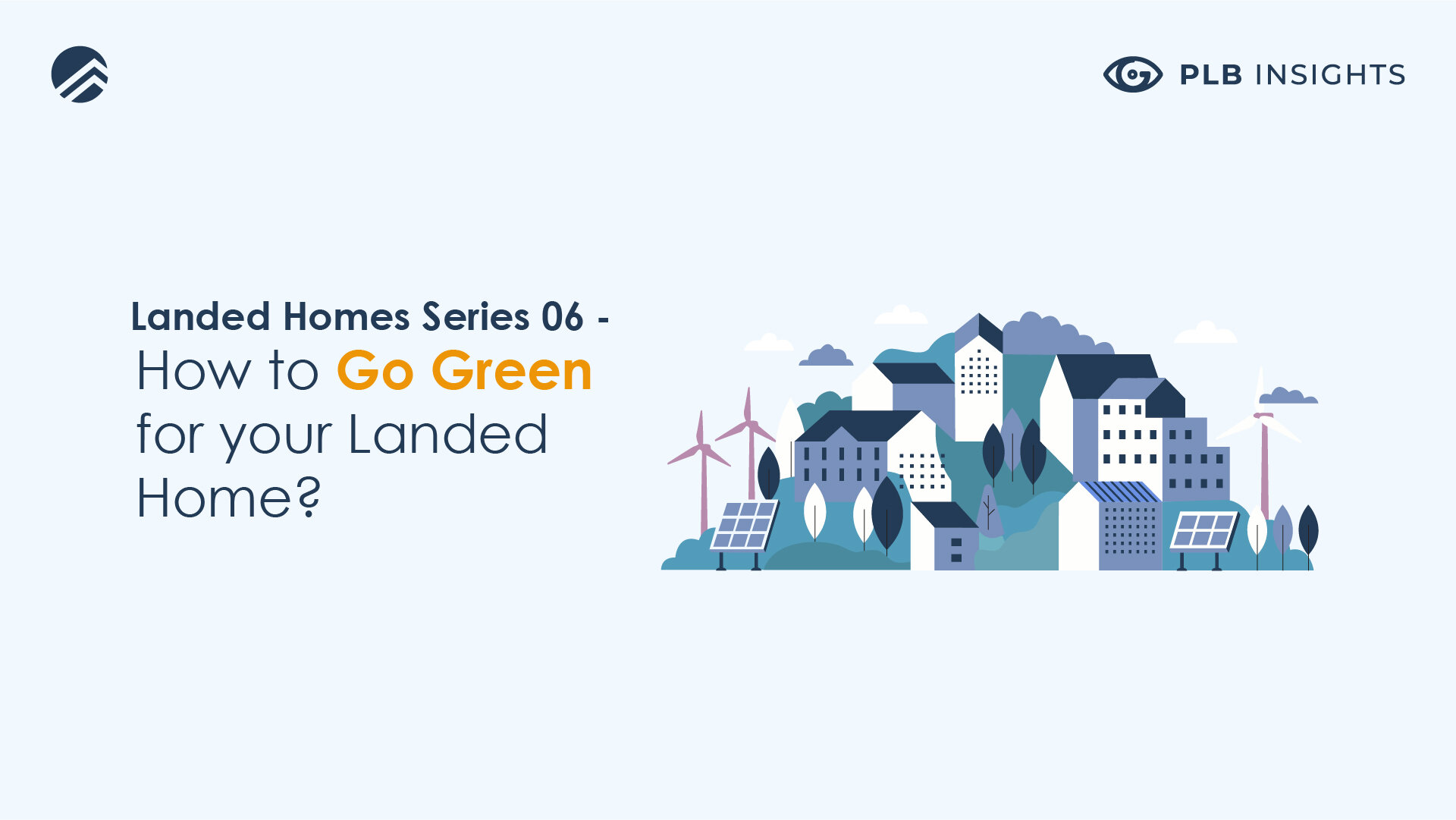
Climate change awareness is on the rise, and the younger generation embraces the idea of green living towards a more sustainable lifestyle. This can be associated with the fact that the aforementioned populace are more eco-centric and are getting more exposed and educated about the effects of global warming and how to then move towards the betterment of the environment around them. We can observe the quick take-up rate for initiatives such as “No Plastic Straws” that shook our nation and even Greta Thunberg’s call to action that is revitalising and drawing back the attention to the importance of sustainable living in our world today, where urbanisation is happening at a much faster pace as compared to previous decades.
In today’s landed series article, we will be shifting our focus to sustainability for landed homes – how exactly can landed owners make this smooth transition to a greener lifestyle for their homes?
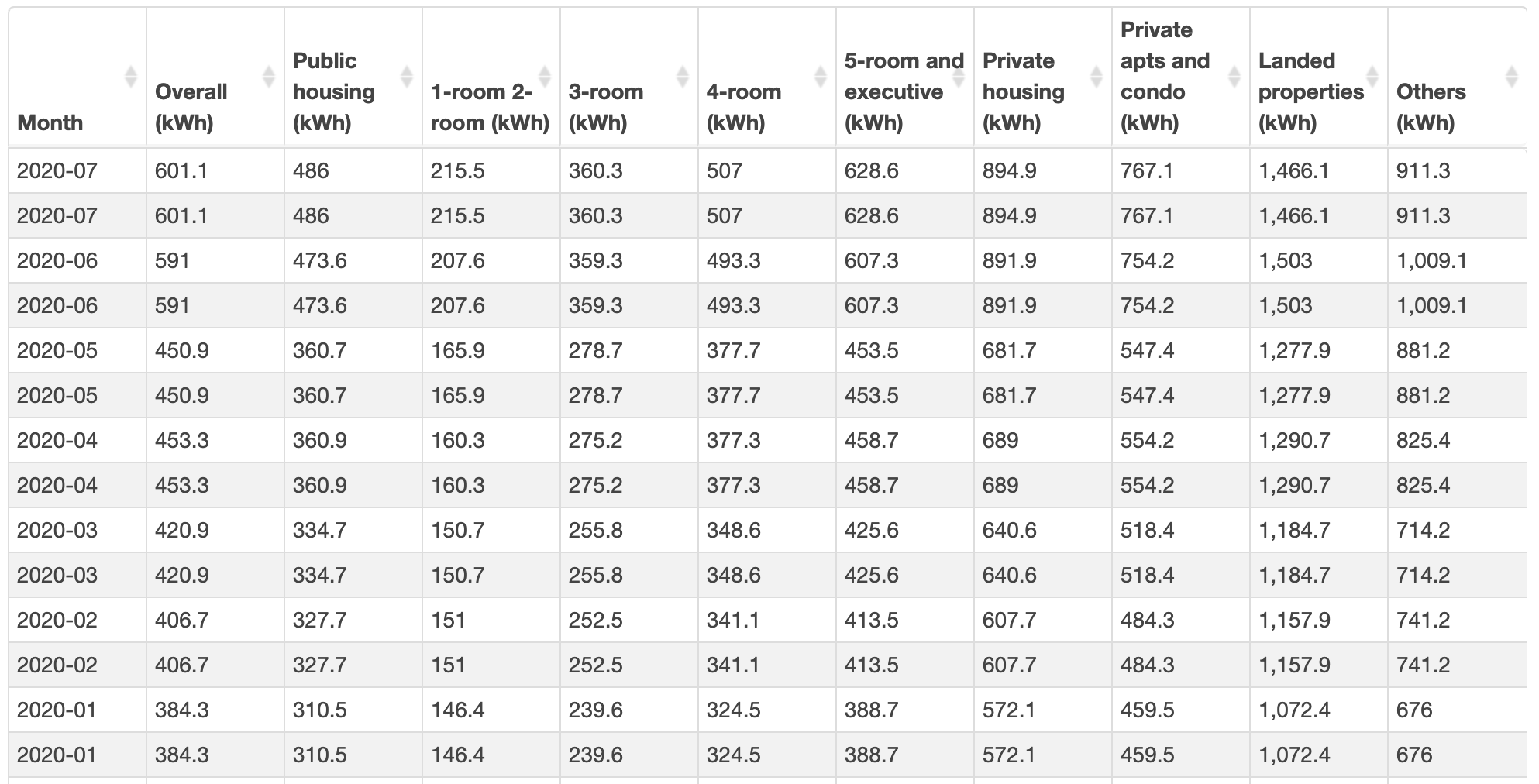
Table showing monthly utility bills for different housing types Courtesy Data.gov
Let’s introduce some facts about landed homes. Monthly utility bills for landed homes tops the list among the rest of residential types in Singapore. This is associated with the fact that landed homes are much bigger and thus there are more appliances and a larger area to be served with electrical and water resources. It is thus vital that sustainability issues be resolved for this specific demographic given their high rates of energy consumption.
Secondly, if you have not already noticed, the government places less emphasis on the landed community when it comes to sustainability plans and is bent on revitalising green living for public housing and private non-landed housing. Thus, the landed community is often left to fend for itself and self-explore the options that they can take on with respect to greening their homes and trust us, there are not many out there.
Before diving deeper into the analysis of some government initiatives that have been rolled out for the landed community to adhere to in terms of switching to a greener lifestyle, let us also take a look at the current sustainability practices that the government has pathed out for the country as a whole.
Just recently in February 2021, the government launched a multi-ministry sustainability plan, known as the Green Plan 2030. Embedded in this Green Plan are initiatives addressing sustainability issues such as vehicular emissions and clean energy resources for our industries, commercial and residential areas alike. Backtracking to a campaign that is still valid even in today’s context would be the widely known Reduce, Reuse and Recycle campaign that was introduced by the authorities way back in 1976. This campaign is still widely adopted by Singapore residents and still serves its purpose of promoting the nation-wide movement of proper recycling habits to save the environment from further degradation.
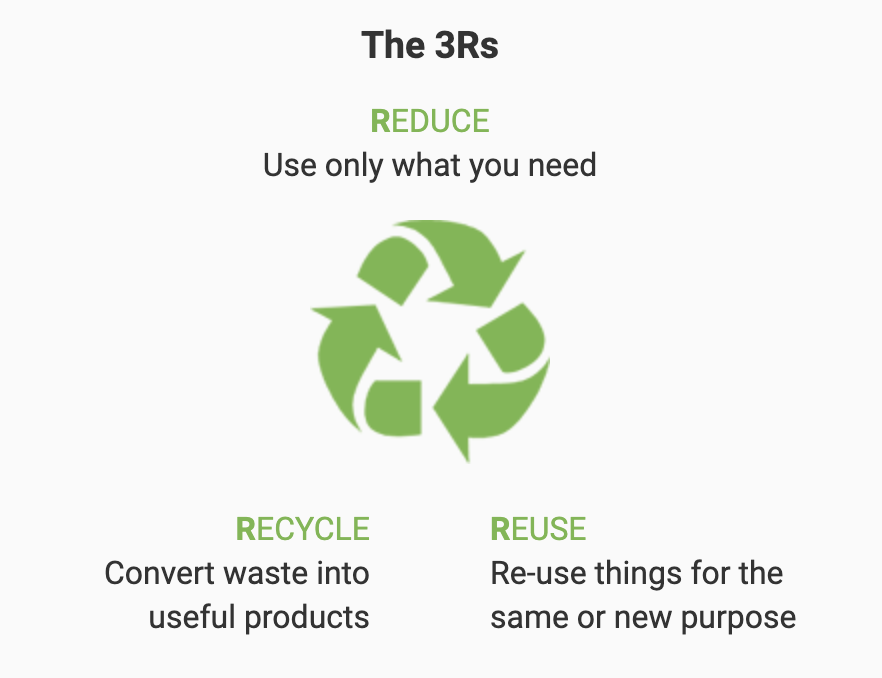
Reduce Reuse Recycle National Campaign Courtesy NEA
Government initiatives
Some government initiatives that have been established for the landed community would include waste collection. For landed homes, instead of disposing recyclables and trash into a common waste collection point like other residential types, each landed household is given two bins, one for recycled items and another for general waste. For bulky waste, they are to engage the service of a professional waste disposal that is approved by the authorities. Failure to do so will result in a fine.
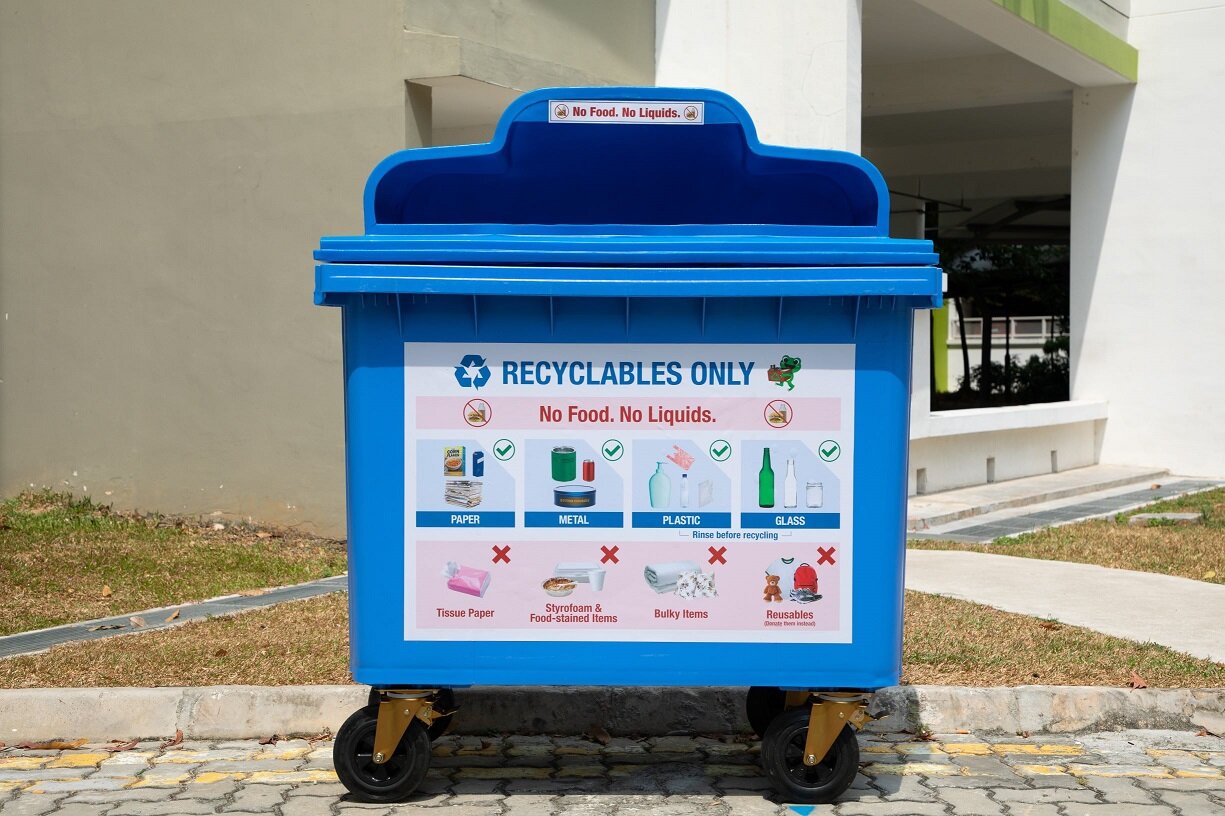
Recycling bin for housing estates Courtesy NEA
Another government introduction would be the construction of green buildings. Under the BCA (building and construction authority), there are certain guidelines to be adhered to when constructing a new building/ landed home. For landed homes, the guidelines were last updated in 2011 but would not be as relevant to those who are not intending to rebuild their entire home since this constitutes more for that of rebuilt houses.
Individual initiatives
Instead of relying solely on the authorities to provide landed homeowners with guidelines as to how to create a greener environment for their homes, they can embark on their individual journey as an environmentally friendly citizen through various ways. Let us now dive in deeper on the different individual initiatives that can be adopted.
Power grids
Singapore is transitioning from the traditional use of power grids to something more environmentally friendly with the gradual introduction of solar panels as an alternative way of generating electricity for our households. However, due to space constraints, such initiatives are not widely used given that electricity generated from solar panels would require the installation of multiple panels instead of merely a few. This is one problem that is being faced by the public housing in Singapore where space is not ample. However, for the landed community, they would not need as much solar panels and can afford some space for the installation of solar panels. Thus, the call is to landed owners to switch from the traditional grids to a more sustainable grid of solar powered energy.
Landed owners who adopt the installation of solar panels get to enjoy a few perks that are exclusive to them. Apart from reducing carbon footprint, energy efficiency will also lead to the reduction of total energy consumption and costs. Excess power that is generated through the panels can also be sold back to the grid.
Owners who decide to embark on this switch can do so through Sembcorp, among other companies available.
How banks are helping landed owners
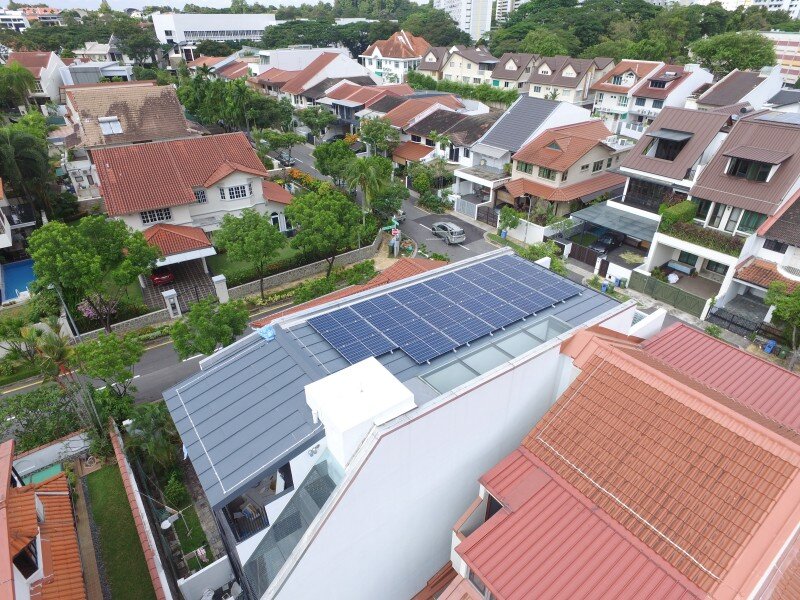
Solar panels on a landed home in Singapore Courtesy Eigen Energy
It is known that to switch from the traditional power grids to one that is operated via the generation of solar energy can often come at a hefty price. Local initiatives by banks have been introduced, whereby banks are allowing landed owners to take up loans for their purchase of solar panels to be installed in their homes. Such initiatives come from banks like OCBC, they are allowing homeowners to loan up to $30,000, as part of their push towards greener and renewable energy usage in Singapore. This is also a partnership between OCBC and Sembcorp, the main proprietor in the transition from traditional power grids to renewable sources of energy through photovoltaic cells.

Sustainability for landed homes

How a rainwater harvesting system works Courtesy Wikipedia
There are already some developments that are adopting the rainwater harvesting system for landed homes. Rainwater harvesting systems act as a buffer between the air and land boundaries, allowing the rainwater that is collected to be repurposed for gardening or for a water feature instead of flowing directly into the public drainage system. Such a feature would allow homeowners that do gardening to save on water usage and also encourages the use of rainwater.
However, these developments are mostly cluster houses and strata landed properties in an existing condo development, which means that such facilities and initiatives are governed and included in the price tag of the house when owners purchase it. Examples would be the Cluster Houses over at Luxus Hill Contemporary Collection, Parkwood Collection and Verticious. But fret not, we will bring you a case study of Singapore’s first zero-carbon house in a short while, where such technology is being integrated into the design of this 2-unit lone standing home.
Many times, sustainable houses are brought about via the use of sustainable design of the home. As seen from the New York townhouses and those in the UK alike, there is so much more to be explored in the world of sustainable interior design.
In the rest of this article, we will share with you some ways to make your sustainable green switch Affordable, Adaptable and Advantageous, introducing to you some sustainability terms such as passive technology, net-zero energy and carbon-negative. What do they mean exactly? Read on to find out.
Passive Homes
Passive houses are becoming more popular among the masses, especially in western countries. So what encapsulates a passive house? A passive house is a home that is built to match up with the Passive House standard by first approaching the design of a tight wall that envelopes the home. This method consists of insulation, thermal heat bridging, and sealing of air. Windows, doors, and any other penetrations are all extremely high-performing as well to ensure that heat is lost appropriately. The Passive House standard relies on a collaboration of energy efficiency with passive solar and internal heat gains to gradually and effectively reduce space heating in a home and allow for simplified methods of providing heat. Let us show you some examples of how a passive home design looks like.

What are some features of a passive home Courtesy BioEnergy Consult
Home designs with the integration of passive technology can be affordable, adaptable and advantageous, which green designers feel that it is just a matter of time that such green infrastructure will become a new normal for Singaporeans and globally.
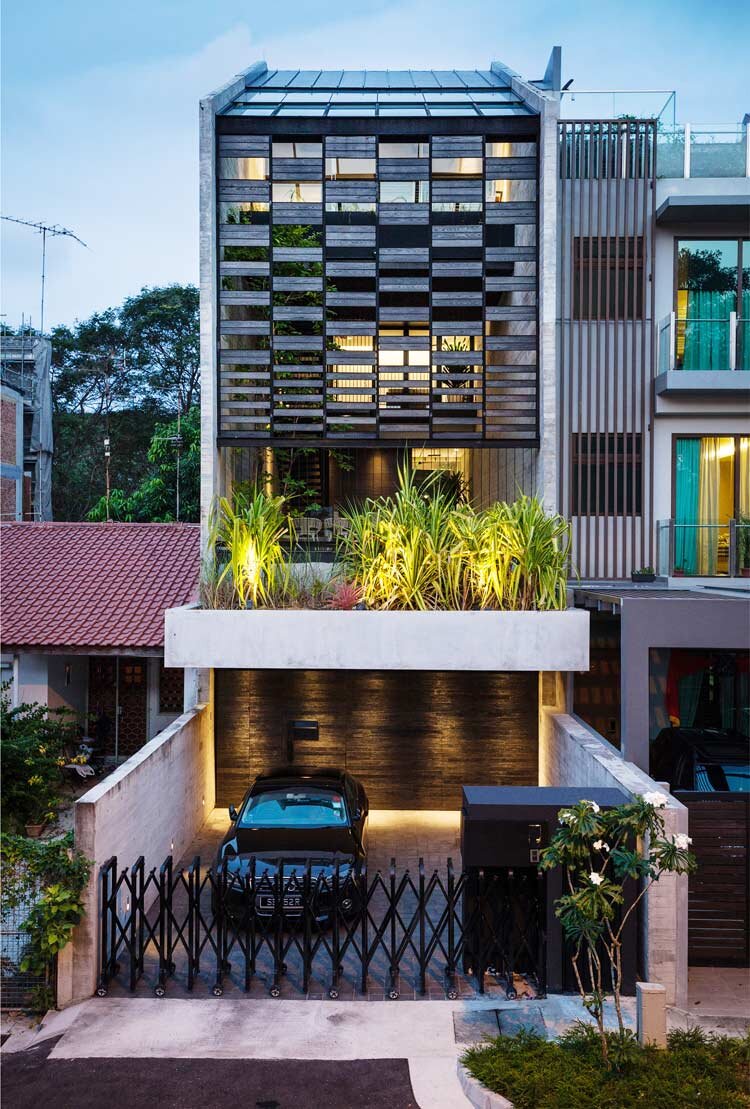
How a passive green house looks like in Singapore (we know, you totally can’t see it!)
Although you cannot spot a passive house with your naked eye, its benefits are unlimited. Passive houses allow its owners to enjoy low monthly energy use and big savings with the use of mechanical ventilation, high indoor air quality, flexibility in building materials and a future-proofed home that is definitely worth showing off to visitors. It is reported that a passive house can optimise energy efficiency and cut energy requirements by 90%! But that is in the Western countries though, and for Singapore, energy efficiency will definitely not go that far but will go higher than normal housing designs.
Building restrictions
Some homeowners may have always wanted to change the facade and landscaping of their homes to make it more environmentally friendly. However, given the restrictions for the URA, many are not able to go through with their plans. The URA has provided some guidelines based on the setback that is required of every landed property. The failure to follow through with the regulations will result in the issuance of a fine to owners. The setback requirements sometimes disallow owners to fully unleash the inner creativity to design their own eco friendly homes.
Let us now go into a case study of this special landed homeowner in Singapore that has managed to push the boundaries and incorporate innovative green techniques into their homes without violating any of the setback rules and restrictions.
Case Study: First Carbon-negative house in Singapore
What does it mean for a home to be carbon-negative? A zero carbon house in theory, produces zero or even negative CO2 emissions through maximising energy efficiency, which includes all housing appliances and infrastructure. More often than not, a carbon-negative home comes with the use of passive design and technology. Another noteworthy trait of zero carbon houses is that they incorporate renewable energy into their energy use. This way of living is another way on top of the previously mentioned passive houses to become more cost-effective and less energy intensive. Especially given that it is a common knowledge that landed homes generally use more energy as compared to other residential types.
For today’s deeper insight, we will be looking into Singapore’s first carbon-negative house, more widely known as The B House.
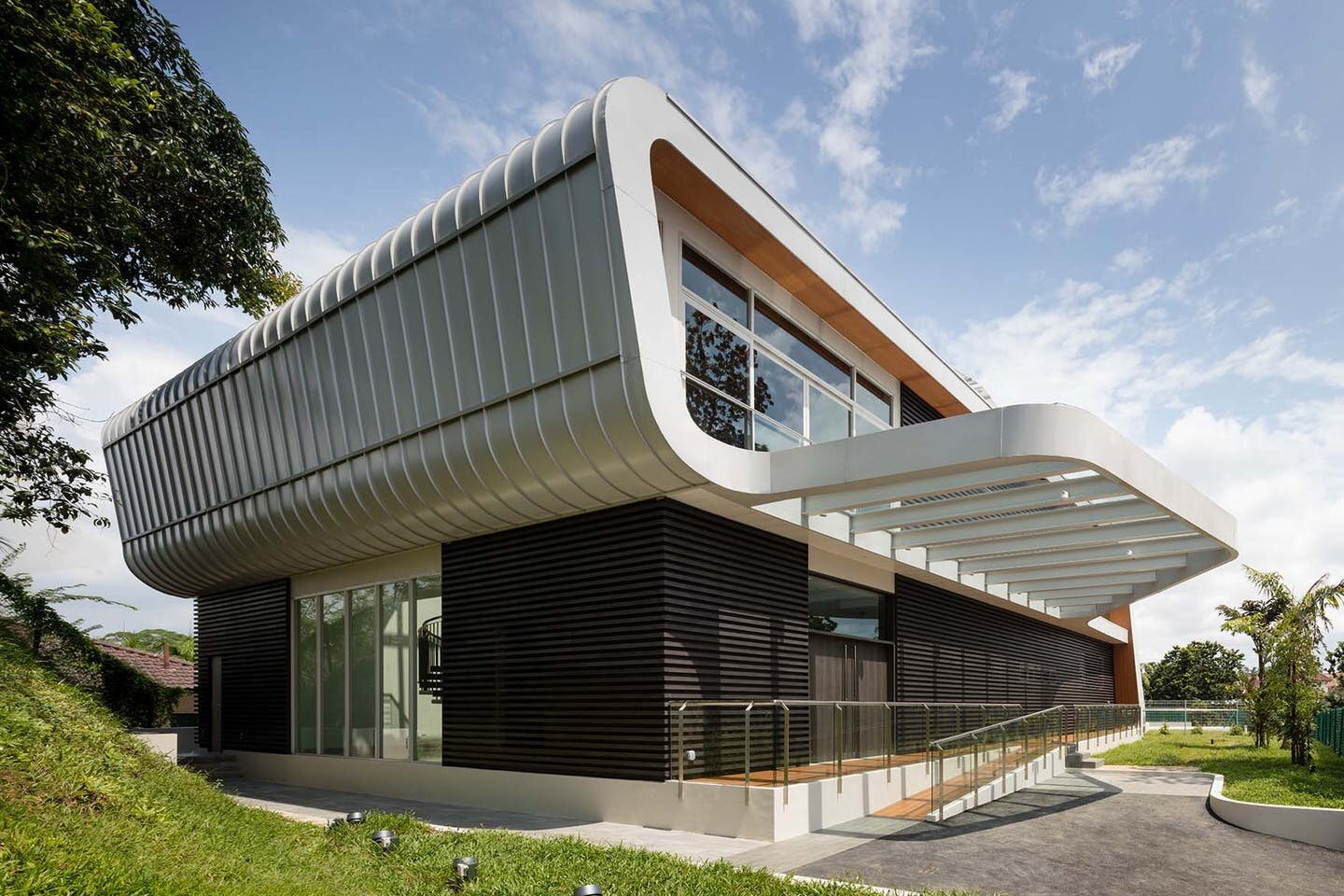
The B House Courtesy Eco Business
This pioneering carbon-negative house was inspired by Asia’s first zero-carbon prototype home in Malaysia. The designer of the home was Pomeroy Studios, Pomeroy applied many design techniques used in Singapore’s colonial black-and-white bungalows and also made use of more passive design techniques to showcase the energy-efficient features of the 2 large-sized units combined. This was taken into account due to the fact that Singapore experiences year-round hot climatic conditions, so a climate matching technique was applied to the housing design concept to better bring out the energy and water efficiency of the home. It is all a work of science in architecture. Designers were then also able to cut down on the heat absorbed from the sun and maximise cross-ventilation within the home itself.
This house has a water harvesting plant that was installed, which allows owners to save up to 465 m3 in a year! Materials used to build this installation were also made of recycled content and pre-fabricated materials. Bringing it full circle, the house is also equipped with solar panels on its roof, which is able to generate twice as much electricity. Because of all these intricate green additions and design of the home, it was awarded the Green Mark Platinum Award, which is an award that is given to sustainable designs of new-builts by the Building Construction Authority (BCA). However, this award will not be applicable for homes that are already built and owners decide to do A&A works.
Why are we bringing up this case study? It is to present to readers the idea that technology is not the only way to bring about a green change around your homes. It is rather dependent on your own creativity to push the boundaries given what you already have and the restrictions that are legally binding – making use of different more environmentally conscious materials and designs for your home.
Net Zero Energy house
Next, we will be moving to net zero energy houses. What encompasses a net zero energy house and how is it different from the previous sustainable concept designs that we’ve been exposed to?
There are many terminologies involved in the building of net-zero-energy buildings. To put it simply, a net zero energy house is defined as when a house is fully self-sustainable and able to generate its own energy for its own use without having to be dependent on the traditional third party power grid source, over the course of one year. So think about it this way, the power your property gets from the power grid will be returned with that generated from your own facilitation plants. Most people who are not familiar with the term “net-zero-energy” will think that this is all about solar voltaic cells being installed on the roof of your home, think deeper, it is much more holistic than that.
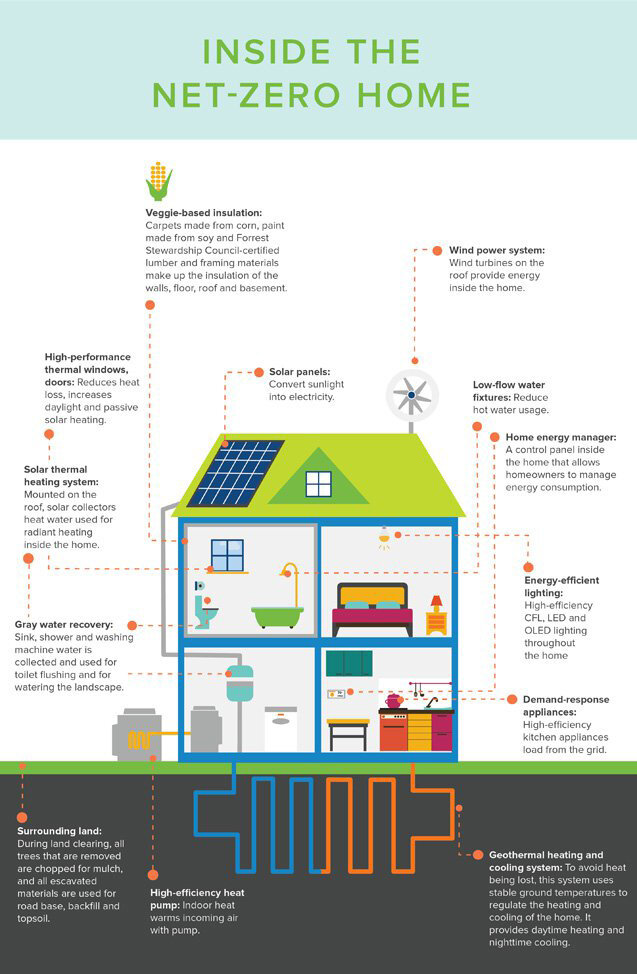
How a net-zero home can look like Courtesy inhabitat
This investment that owners decide to take faith in could require an upfront cost that is not for the faint of heart. However, this will eventually be offset by what homeowners can save on their electric bill. It can take anywhere from three to seven years for homeowners to experience savings from that point onwards.
What is the difference
So far in this article, we have been exposed to three different types of concepts. Although they may theoretically sound like the same methodology, the contribution that they have is very different.
Let us start off with net-zero energy, because it sounds like it can be made up of both passive home design and a carbon-negative design. And it is true, having all 3 elements would be enlightening and the effect will definitely be augmented. But net zero houses are basically homes that contribute back electricity to the power grid, and in that sense, the net energy used is zero.
For a passive home, sustainable practices are adopted in the walls and insulation of the home itself, so very much about the overall facade and technology of the home infrastructure. Carbon-negative basically means to be climate positive, being able to reduce most if not all greenhouse gas emissions and eliminating the rest of negative impacts that can be brought about in a home. So essentially, it is similar to net zero energy homes, but instead of contributing energy back, carbon-negative tries to eliminate any form of carbon emissions.
What can be done better
The government places a lot of emphasis on public housing and the landed housing community seems to be a little overlooked and excluded from sustainability practices in Singapore. In the city of rules and regulations, there aren’t many restrictions for landed homes in terms of what they can do but does it really mean that residents are free to roam sustainable practices for their houses? Apart from following setback requirements, are monetary terms all that matters? There are many ways for landed homes to be as sustainable and environmentally friendly compared to their public housing counterparts.
For a guide on how to do so for your home, visit our mini article here whereby we shared 5 tips on how to go greener for landed homes, which definitely complements the content that we covered in today’s article!
However, in general for landed homes, it is up to the responsibility of the homeowners to make the transition instead of it being directed by the government. We do feel that the government ought to provide more guidelines and incentives for the landed community to make the transition into a more sustainable lifestyle and environment for their homes.
Something that can be taken into consideration on the part of the government would be feeding construction materials made of slag and incinerated waste products to the general public, also more widely known as NEWSand. From NEWater to NEWSand, the government aims to create a cycle/ loop with respect to the waste generated by our population, so that no waste would go to waste, ensuring a self-sustainable Singapore whereby resources are built from our wastes. Currently, such innovation is only available in a limited range as the authorities are still in the midst of testing the integrity of the technology. An example of the usage of this material would be the park connector pavement opposite Our Tampines Hub.
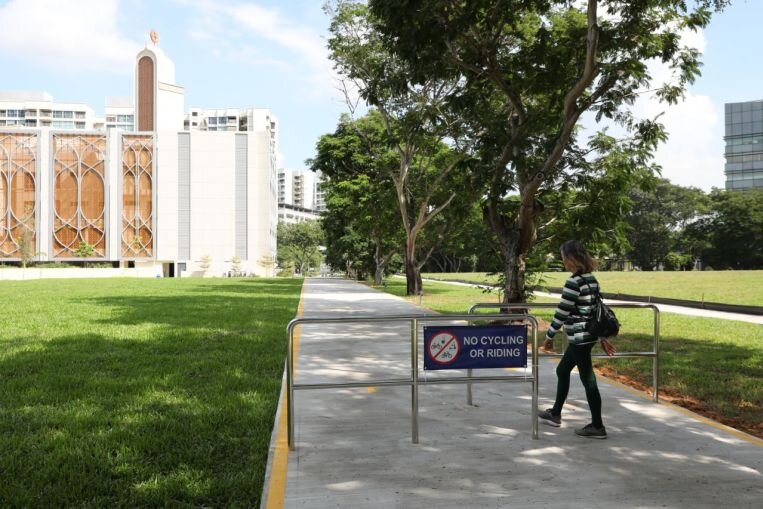
Cycling path that is made with NEWSand Courtesy Straits Times
This part of the cycling path that is made from NEWSand spans 105m. NEWSand when fully rolled out to the public, will be a good form of recycled and precious resource made from waste to reduce the amount of waste that is sent to the already overcrowded Semakau landfill.
Conclusion
If you do live in a landed home, you are blessed with the amount of transforming possibilities. As compared to an apartment complex where most utility sources are shared and needless to say, the lack of space and authority for you to alter any form of shared physical spaces
In conclusion, we do feel that there is much potential in the landed community that can be realised with regards to green infrastructure and initiatives. Landed homeowners just have to take that first step of courage to move forward on the journey towards a more sustainable lifestyle, apart from just practicing the national 3 R’s campaign, because there is just so much more potential that they can bring out with their homes. There is never a right time to start, but all it takes is the first step. Considering that the green movement is just picking up speed, now may be a better time than ever to do so, to contribute to the positive impact of climate change. Follow your heart and let’s start on this sustainable living journey together! We’ll see you in our next Insights article!








